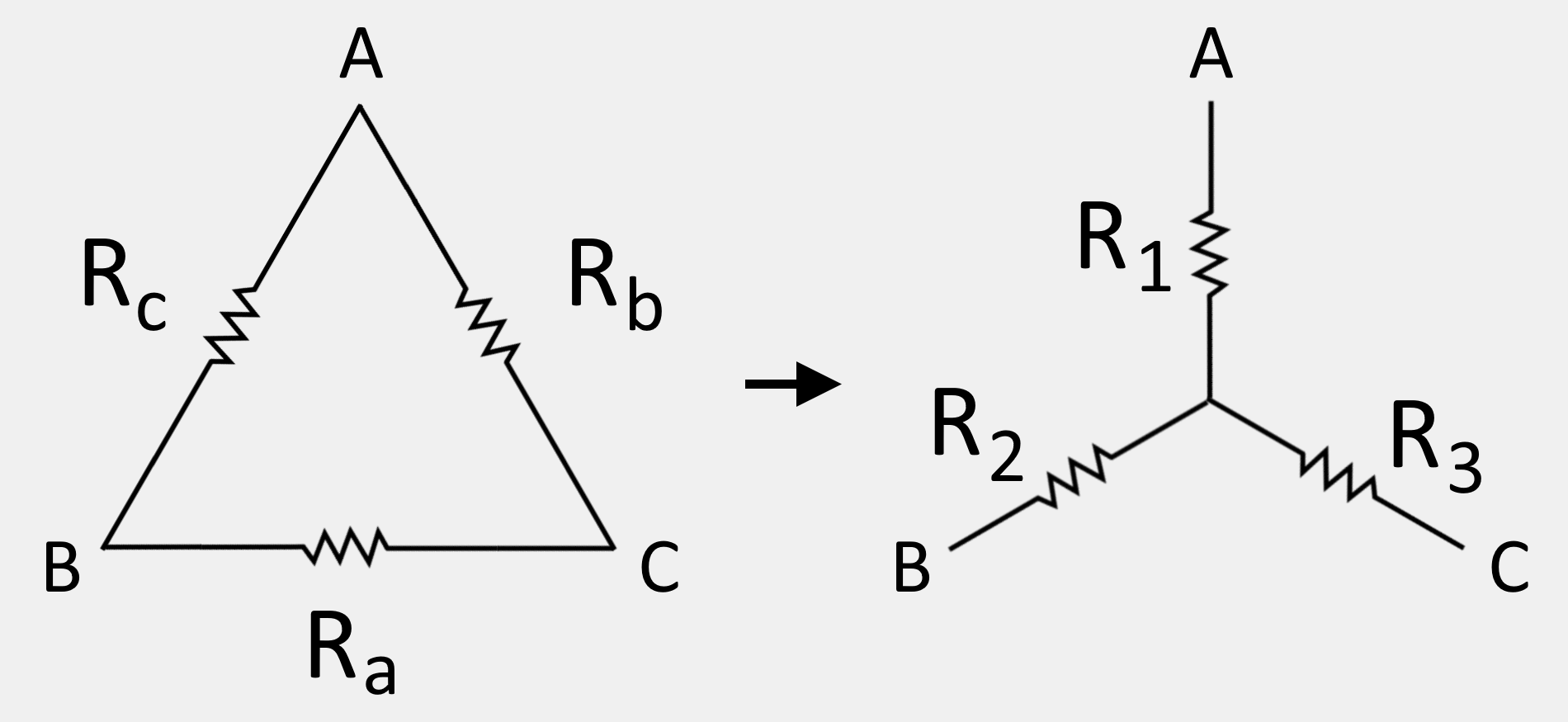Delta to Wye Conversion
This delta to wye conversion calculator will help you transform a delta network of resistors to a wye network (or 'Y" network) and vice versa. In this calculator, you will learn:
- The difference between delta and wye networks of resistors;
- The formulas for delta to wye conversion;
- How to convert delta to wye networks;
- How to use our delta to wye conversion calculator; and
- Some applications of delta and wye networks of resistors.
Keep on reading to learn how to transform a complicated electronic circuit with wye and delta diagrams into a simple one (with only parallel and series-connected resistors) using the delta to "Y" conversion.
Delta vs. wye network of resistors
In electronic circuits, the resistor (shown in the image below) is one of the most critical components and has a wide variety of uses. We can use resistors to limit the current in a circuit or the voltage flowing towards another component of the circuit.

Since circuits can have multiple components, like capacitors, inductors, LEDs, motors, and so much more, circuits can also have many resistors in them. Resistors in circuits are usually connected in parallel or series but can sometimes form loops and multiple-branch networks, which we see in more complicated circuits. The simplest loop that resistors can make is the delta network, as shown in the diagram below:
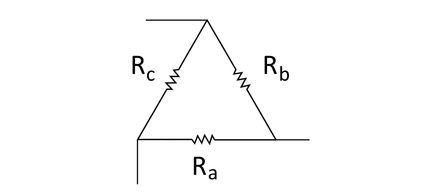
In electronic diagrams, we usually represent a resistor by a zigzag line. In a delta network, we connect three resistors to three nodes (represented by A, B, and C) that lead to three different parts of a circuit. We call it a "delta" network because, in its simplest diagrammatic representation, this network forms a triangular shape just like the uppercase Greek symbol delta Δ.
The difference between a delta and a wye network is that, in a wye network, we connect the said three nodes in a different fashion by extending the three nodes using three resistors and connecting all these resistors to a single node. This forms something like the letter Y, hence the name "wye" network. Here is what a wye network looks like:
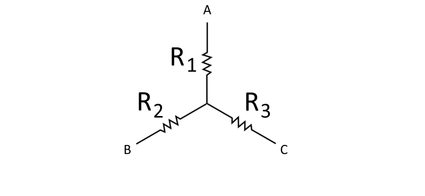
To perform a delta to wye conversion, we have to determine the set of resistors to use that will result in an equivalent overall network. The currents and voltages that pass through each of the three nodes must be the same in both types of networks. This is where our delta to wye conversion calculator comes in handy.
However, if you wish to learn how to convert delta to wye networks and vice versa, we will show you how to do so in the next section.
How to convert delta to wye networks and vice versa
Knowing how to determine wye or delta networks in a circuit is the first step in conversion. Converting delta networks to wye networks is a matter of determining the "delta" in a circuit, knowing the resistance values of each resistor in the delta, and using the formulas we included in this text.
The same procedure also applies in the conversion of wye networks to delta networks. However, in this operation, we first have to determine which "wye" needs converting, then find the resistance values in each leg of the wye network. Finally, we substitute these values into the formulas provided below.
Delta to wye conversion formulas
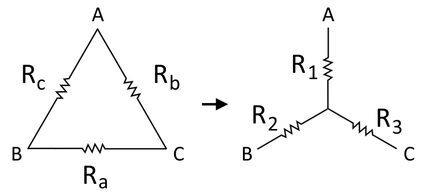
where:
- Ra, Rb, Rc are the resistances in the delta network,
- R1, R2, R3 are the resistances in the wye network.
Wye to delta conversion formulas
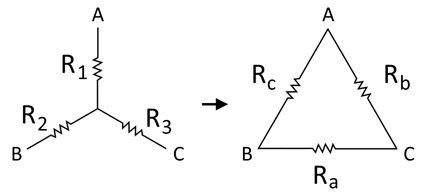
where, as previously seen:
- Ra, Rb, Rc are the resistances in the delta network,
- R1, R2, R3 are the resistances in the wye network.
If you are looking at an actual circuit and you want to know the resistance value of a resistor without using a multimeter, you can tell it by looking at its color bands. You can use our resistor color code calculator to easily determine its corresponding resistance value. On the other hand, to further understand how to use the formulas above, let us consider an example in the next section of this text.
Delta to y conversion. Sample calculation
For our delta to y conversion (delta to wye conversion) calculation, let us consider the slightly complicated circuit shown below and convert the delta network (highlighted in green) to a wye network:
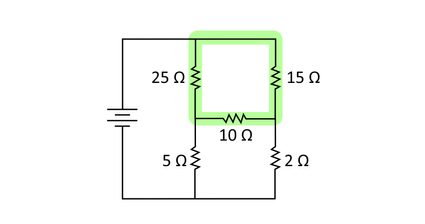
The delta diagram might seem different from the ones we showed earlier, but if you look closely, we can draw the delta shape like this:
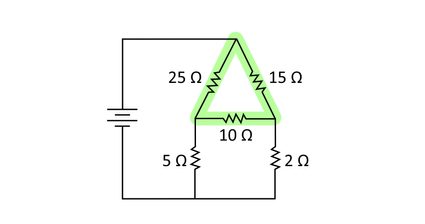
Now that we can see the familiar delta diagram in the circuit let us now draw the corresponding equivalent wye network that our delta network will be transformed into. We can simply draw it over the delta network to preserve the location of the nodes or we can draw the new wye network in a separate equivalent circuit. This is also the best time to label our resistors with the same variables we have in our formulas and reference diagram, as shown below:
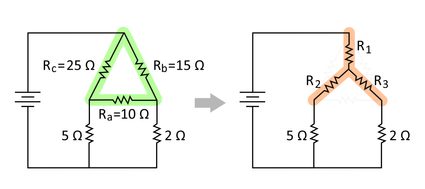
Once we have it all set up, we can now use the formulas we have for the delta to wye conversion to find the resistance values for each resistor in the equivalent wye network for the given circuit. Here is the calculation of each resistance value:
From these computations, we can now replace our delta network with a wye network using another set of resistors with resistance values of 7.5 Ω, 5.0 Ω, and 3.0 Ω for R1, R2, and R3, respectively.
Importance of transforming delta and wye networks
You may have noticed that in the example above, the original network did not have any parallel or series connections for any of the resistors. Instead, there were two deltas that cannot be simplified without the knowledge of delta to Y conversion.
After conversion, we can now see that R2 resistor = 5 Ω is now in series with the other 5 Ω resistor. In that case, they can now be simplified even further by adding their resistance values together and replacing them with a single 10 Ω resistor. You can learn more about series resistors by checking out our series resistor calculator
With that said, delta to wye conversion, and vice versa, is the perfect method to simplify complicated circuitry when performing circuit analysis. We perform circuit analysis to determine the current or voltage flowing in our electronic circuit( three phase calculator), and it is best done with a simplified circuit or some parts of it.
How to use our delta to wye conversion calculator
Our delta to wye conversion calculator is two calculators in one. In spite of this, they are both quite easy to use. To use this calculator, you first need to choose from the options wye to delta and delta to wye. Whatever you choose from these two options will make the calculator for that particular option available to you.
-
So, if you choose the option delt to wye, you will be able to enter the values for Ra, Rb and Rc (the resistances in the delta network) and the delta to wye converter will then return the values for R1, R2 and R3 (the resistances in the wye network).
-
If, on the other hand, you choose the option wye to delts, you will be able to enter the values for R1, R2, and R3 (the resistances in the wye network), and the delta to wye converter will then return the values for Ra, Rb, and Rc (the resistances in the delta network).
Do you wish to learn more?
If you find this calculator and text useful and informative, perhaps you would find our electricity cost calculator fun and valuable too. In there, you will learn how to calculate your electricity cost depending on the power you use at home.
FAQ
How can I determine what is delta or wye?
The names delta and "wye" comes from the shape of the letter-like diagrams, so look at the shape of your resistor network. The delta configuration has three resistors connected like a triangle or the Greek letter delta - Δ. In the "wye" configuration, all the resistors are connected at one point and resemble the letter "Y".
Why a wye or delta connection is required in a circuit
If you have a circuit with multiple resistances, you can use the delta-to-wye conversion to easily simplify the given circuit/resistor network. These connections are required if the resistor network cannot be simplified using the usual serial and parallel combinations. Then you can solve the circuit and find the resistances in the equivalent wye network.
How can I convert a delta circuit with 4Ω resistors to wye?
To perform a delta-to-wye conversion for a delta circuit with 4Ω resistors:
- Calculate R1:
(Rb × Rc)/(Ra + Rb + Rc) = (4 × 4)/(4 + 4 + 4) = 16/12 = 1.33 Ω. - Calculate R2:
(Ra × Rc)/(Ra + Rb + Rc) = (4 × 4)/(4 + 4 + 4) = 16/12 = 1.33 Ω. - Calculate R3:
(Ra × Rb)/(Ra + Rb + Rc) = (4 × 4)/(4 + 4 + 4) = 16/12 = 1.33 Ω.
Can I do a delta-to-wye conversion for every resistor network?
Yes, a delta-wye transformation has the nice property that you can always turn a delta into wye and you can always turn wye into a delta, regardless of the value of the resistances involved. So you can always simplify three-resistor networks using the delta-wye conversion.
What is the current for delta and wye: AC or DC?
AC. Delta and wye resistor networks are often found in 3-phase AC power systems. Single-phase AC is supplied to our homes, while 3-phase AC is widely used in distribution systems and industrial equipment. A 3-phase system is more efficient because it can deliver more power.
What will be the resistances in a 4Ω circuit when going from wye to delta?
Each resistor has 12Ω. Use the wye to delta equations to calculate the new resistances:
Ra = R2 + R3 + (R2 × R3 / R1) = 4 + 4 + (4 × 4/4) = 4 + 4 + 4 = 12 Ω.
Rb = R3 + R1 + (R3 × R1 / R2) = 4 + 4 + (4 × 4/4) = 4 + 4 + 4 = 12 Ω.
Rc = R1 + R2 + (R1 × R2 / R3) = 4 + 4 + (4 × 4/4) = 4 + 4 + 4 = 12 Ω.
